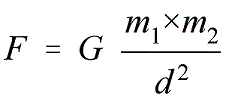
- Force is any interaction that changes or tends to change the state of rest or of uniform motion or the shape and size of a body.
- It is called a vector quantity as it has both magnitude and direction.
- The SI unit of force is Newton and its CGS unit is Dyne. (1N =105 dyne)
- Frictional force, gravitational force, electrostatic force, magnetic force etc. are some examples of forces.
Gravitation:
- Gravitation or gravitational force is the force of attraction between any two bodies due to their masses.
- Sir Isaac Newton from England was the first person to say that every object in this universe attracts every other object with a force called gravitational force.
- Newton’s law of gravitation states that,” Every object in the universe attracts every other object with a force which is directly proportional to the product of their masses and inversely proportional to the square of distance between their centers”.
- The value of G (Universal Gravitational constant) is numerically equal to the gravitational force produced between two bodies with mass 1 kg each placed at a distance of 1 m from their centers, which is equal to 67×10-11 Nm2/Kg2.
*If ‘G’ by some miracle was suddenly multiplied by a factor of 10, we would be crushed to the floor by the earth’s attraction and if ‘G’ were divided by this factor, the earth’s attraction would be so weak that we would be able to jump over a building easily.
- Value of G was first calculated by Henry Cavendish, a French scientist (1731-1810) by using sensitive balance.
Major consequences of Gravitational force:
- Revolution of planets around the sun
- The sea tides occur due to the gravitational attraction of the sun and the moon, and are maximum on full moon day.
- Rainfall on earth
- Revolution of natural satellites around the planets
Gravity and acceleration due to gravity:
- Gravity is the force by which any heavenly body pulls any other object towards its center.
- Gravity depends on the mass of the object.
- The weight of a body is the force of gravity acting on the body.
- The gravity of the earth is about 6 times more than that of the moon. Thus, a body weighing 100N on the moon weighs 600N on the earth.
- Effects of gravity:
- Falling of objects towards the center of the earth
- Stability of large buildings and bridges
- Existence of the atmosphere on the surface of the earth
- Flowing of rivers and blowing of wind
- The acceleration produced in a freely falling body due to the influence of gravity of a heavenly body is called acceleration due to gravity.
- It is denoted by g and its SI unit is m/s2.
- Effects of gravity:
Acceleration due to gravity on earth:
- Acceleration due to gravity (g) on earth is inversely proportional to the square of radius (R) of the earth.
- The earth is not a perfect sphere. It is flat at the poles (less radius) and bulged at the equator (more radius). Due to these unequal radii, the value of g is more at poles (9.83m/s2) and less at equator (9.78m/s2).
- Acceleration due to gravity (g) is independent of the mass of the body. All freely falling bodies, small or large, in the absence of air resistance, fall together on the surface of the earth under the same effect of g.
- Since the distance from the center of the earth to a certain height (R+h) is greater than that on the earth’s surface, the value of g is less at the given height than that on the surface of the earth. Hence, the value of ‘g’ is less at the top of the Everest than at its foot.
Free fall and weightlessness:
- When a body is falling freely only under the effect of gravity without any external resistance, it is called free fall.
- A body falling freely in vacuum is an example of free fall.
- When a body is in a state of zero weight, it is called weightlessness. It is a condition at which a body having certain mass becomes weightless.
Conditions for weightlessness:
- When a body is falling freely only under the action of gravity, i.e. the reaction force is zero during the free fall.
- When a body is in space at null point where g=0.
- When a body is in a spaceship orbiting around a heavenly body, the body inside the spaceship is in a state of free fall and hence weightlessness.
- When a body is at the center of the earth, i.e.g=0.
